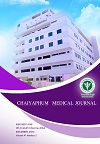Outcome of Treatment between Ureteroscopy and Extracorporeal Shock Wave Lithotripsy on Ureteric calculi Patients in Chaiyaphum Hospital
Keywords:
outcome of treatment, ureteric stones, ureteroscopy, extracorporeal shockwave lithotripsyAbstract
Background: Ureteral calculi is a public health problem. The symptoms were colicky pain, hematuria and may be obstructive urinary tract. The ureteroscopy (URS) and extracorporeal shock wave lithotripsy (ESWL) method are effective management. There are no surgical wound, less pain, short-term hospital stays and return to work faster.
Objective: 1) To comparison outcome of Treatment between ureteroscopy and extracorporeal shock wave lithotripsy on ureteral calculi’s patients in Chaiyaphum Hospital. 2) To study risk factor related outcome of Treatment between ureteroscopy and extracorporeal shock wave lithotripsy on ureteral calculi’s patients in Chaiyaphum Hospital.
Methods: This is an analytical retrospective study with 100 the reviewed medical records of ureteric calculi patients, between 2016 January 1st to 2018 December 31st. The one hundred samples was inclusion criteria who have 50 patients were treated with ureteroscopy (URS) and 50 Extracorporeal Shock Wave Lithotripsy (ESWL). The patient’s characteristics data were analyzed using percentage, mean standard deviations and chi-square test, fisher exact test, independent sample t-test, and adjusted odds odds ratio with 95% confidence interval p-value <0.05.
Results: Compare the results of treatment for URS method was good outcome more than ESWL method (OR, 0.37, 95% CI 0.14-0.96) and significantly (p-value<0.05). Factors related outcome of treatment between URS and ESWL were performed and significantly; procedure time (OR,-14.5; 95% CI, -24.1-4.9) then age, stone size, comorbidities, complication and BMI were not significantly. (p -value >0.05)
Conclusion: The URS treatment for ureteric calculi was good outcome more than ESWL treatment. There were more stone free rate, reduced treatment rate and recurrence rate but complications from treatment was no difference.
References
Jeevaraman S, Selvaraj J, Niyamathullah NM. A Study on Ureteric Calculi. International journal of contemporary medical research, 2016;3(10):2969-72.
Sierakowski R, Finlayson B, Landes RR, Finlayson CD, Sierakowski N. The frequency of urolithiasis in hospital discharge diagnoses in the United States. Invest Urol, 1978;15(6):438–41.
Yanagawa M, Kawamura J, Onishi T, Soga N, Kameda K, Sriboonlue P, et al. Incidence of urolithiasis in northeast Thailand. Int J Urol, 1997;4(6):537-40.
Masarani M, Dinneen M. Ureteric colic: new trends in diagnosis and treatment. Postgrad Med J, 2007;83(981):469–72.
Brenner DJ, Hall EJ. Computed tomography--an increasing source of radiation exposure. N Engl J Med, 2007;357(22):2277-84.
Zilberman DE, Tsivian M, Lipkin ME, Ferrandino MN, Frush DP, Paulson EK, et al. Low dose computerized tomography for detection of urolithiasis – its effectiveness in the setting of the urology clinic. J Urol, 2011;185(3):910-4.
Mariappan P, Loong CW. Midstream urine culture and sensitivity test is a poor predictor of infected urine proximal to the obstructing ureteral stone or infected stones: a prospective clinical study. J Urol, 2004;171(6 Pt 1):2142-5.
Lee YH, Tsai JY, Jiaan BP, Wu T, Yu CC. Prospective randomized trial comparing shock wave lithotripsy and ureteroscopic lithotripsy for management of large upper third ureteral stones. Urology, 2006;67(3):480-4.
Chen DY, Chen WC. Complications Due to Surgical Treatment of Ureteral Calculi. Urol Sci, 2010;21(2):81-7.
Tiselius HG, Ackermann D, Alken P, Buck C, Conort P, Gallucci M. Guidelines on urolithiasis. Eur Urol, 2001;40(4):362-71.
Sprunger JK, Herrell 3rd SD. Techniques of ureteroscopy. Urol Clin North Am, 2004;31(1):61–9.
Elashry OM, Elgamasy AK, Sabaa MA, Abo-Elenien M, Omar MA, Eltatawy HH, et al. Ureteroscopic management of lower ureteric calculi: a 15-year single-centre experience. BJU Int, 2008;102(8):1010–7.
Kehinde EO, Al-Awadi KA, Al-Hunayan A, Okasha GH, Al-Tawheed A, Ali Y. Morbidity associated with surgical treatment of ureteric calculi in a teaching hospital in Kuwait. Ann R Coll Surg Engl, 2003;85(5):340–6.
Harmon WJ, Sershon PD, Blute ML, Patterson DE, Segura JW. Ureteroscopy: current practice and long-term complications. J Urol, 1997;157(1):28–32.
Krambeck AE, Murat FJ, Gettman MT, Chow GK, Patterson DE, Segura JW. The evolution of ureteroscopy: a modern singleinstitution series. Mayo Clin Proc, 2006;81(4):468–73.
Grasso M. Ureteropyeloscopic treatment of ureteral and intrarenal calculi. Urol Clin North Am, 2000;27(4):623–31.
โรงพยาบาลชัยภูมิ. สถิติผู้ใช้บริการ ปี 2561-63. ชัยภูมิ : กลุ่มงานศัลยกรรม โรงพยาบาลชัยภูมิ, 2563.
สรวิชช์ ลดาวัลย์. การศึกษาเปรียบเทียบผลการรักษานิ่วในท่อไตส่วนปลายระหว่างการส่องกล้อง (URS) และการสลายนิ่วด้วยคลื่นเสียงความถี่สูง (ESWL). วารสารแพทย์เขต 4-5, 2559;35(3):114-23.
William D. Dupont, Walton D, Plummer Jr. PS - Power and Sample Size Calculation. Online. 2011. [cited : 2010 , 12 September] available : http://biostat.mc.vanderbilt.edu/wiki/Main/PowerSampleSize
El-Qadhi M. Outcome of ureteroscopy for the management of distal ureteric calculi: 5-years’ experience. African J of urology, 2015;21(1):67-71.
Javanmard B, Razaghi MR, Ansari Jafari A, Mazloomfard MM. Flexible ureterorenoscopy versus extracorporeal shock wave lithotripsy for the treatment of renal pelvis stones of 10-20 mm in obese patients. J Lasers Med Sci, 2015;6(4):162–6.
Tiloklurs C, Taweemonkongsap T, Amornvesukit T, Phinthusophon K, Nualyong C, Chotikawanich E. Comparison of Successful Treatment between Ureteroscopic Lithotripsy and Extracorporeal Shock Wave Lithotripsy for Proximal Ureteric Calculi. J Med Assoc Thai, 2017;100(3):150-4.
Ghalayini IF, Al-Ghazo MA, Khader YS. Extracorporeal shockwave lithotripsy versus uroteroscopy for distal ureteric calculi: efficacy and patient satisfaction. Int Braz J Urol, 2006;32(6):656–64.
Verze P, Imbimbo C, Cancelmo G, et al. Extracorporeal shock wave lithotripsy vs ureteroscopy as first – line therapy for patients with single, distal ureteric stones: a prospective randomized study. BJU Int, 2010;106(11):1748–52.
Fankhauser CD, Weber D, Mu¨ntener M, Poyet C, Sulser T, Hermanns T. Effectiveness of Flexible Ureterorenoscopy Versus Extracorporeal Shock Wave Lithotripsy for Renal Calculi of 5–15 mm: Results of a Randomized Controlled Trial. European urology open science, 2021;25:5-10.
Rehman Muhammad FUr, Adnan M, Hassan 3rdA, Akhtar FH, Javed N, Ali F. Comparison of Ureteroscopic Pneumatic Lithotripsy and Extracorporeal Shock Wave Lithotripsy for Proximal Ureteral Calculi. Cureus, 2020;12(4):e7840.
Tripathi SP, Jain DK, Kumar MD, Pathak P. Comparative Study of Ureteroscopy Versus Extracorporeal Shock Wave Lithotripsy in Management of Upper Ureteric Calculi. Innovative J of Medical and Health Science, 2018;8(7):88-93.
Downloads
Published
Issue
Section
License
Copyright (c) 2021 Chaiyaphum Medical Journal : ชัยภูมิเวชสาร

This work is licensed under a Creative Commons Attribution-NonCommercial-NoDerivatives 4.0 International License.





